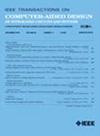用于神经形态计算的超低功耗电解锆突触装置
IF 2.9
3区 计算机科学
Q2 COMPUTER SCIENCE, HARDWARE & ARCHITECTURE
IEEE Transactions on Computer-Aided Design of Integrated Circuits and Systems
Pub Date : 2025-03-14
DOI:10.1109/TCAD.2025.3551654
引用次数: 0
摘要
这项工作提出了一种新的基于电解质的人工突触装置,模仿哺乳动物的突触行为,因为电双层(EDL)用于各种基于神经的应用。ZrO2作为电解质,以铟镓锌氧化物(IGZO)作为通道材料,已被用于Synaptic Device (ZEISD)。一种具有插层特性的新型电解质ZrO2可产生类似生物神经元的突触行为。该装置显示出良好的突触功能,如兴奋性突触后电流(EPSC)、抑制性突触后电流(IPSC)和成对脉冲促进(PPF)。在不同的尖峰振幅和频率下,装置从短期增强(STP)过渡到长期增强(LTP)和抑制特征,这是一种基本的神经行为。FERMI, PRINT和SRH模型已被用于获得神经行为。设计和校准的突触器件具有低至0.162 pJ的超低功耗,获得了更高的开/关比$\约~10^{5}$。我们的发现对推进人工神经形态装置领域具有重要意义,允许创建适应性强的动态功能。本文章由计算机程序翻译,如有差异,请以英文原文为准。
Ultralow Power Zirconium Electrolyte-Based Synaptic Device for Neuromorphic Computing
This work presents a novel electrolyte-based artificial synaptic device mimicking mammalian synaptic behavior because of an Electric Double Layer (EDL) for various neural-based applications. ZrO2, as an Electrolyte, with Indium-Gallium-Zinc-Oxide (IGZO) as a channel material, has been utilised for Synaptic Device (ZEISD). A novel electrolyte, ZrO2, with intercalation property, produces synaptic behaviors similar to biological neurons. The device shows sound synaptic functions, such as excitatory postsynaptic current (EPSC), inhibitory postsynaptic current (IPSC), and paired-pulse facilitation (PPF). With different spike amplitudes and frequencies, the device transitions from short-term potentiation (STP) to long-term potentiation (LTP) and depression characteristics, an essential neural behavior. FERMI, PRINT, and SRH modelling have been utilised to obtain neural behaviors. A higher On/Off ratio $\approx ~10^{5}$ has been obtained in line with designed and calibrated synaptic devices with ultralow power consumption as low as 0.162 pJ. Our findings hold significant implications for advancing the field of artificial neuromorphic devices, allowing for the creation of adaptable, dynamic functionalities.
求助全文
通过发布文献求助,成功后即可免费获取论文全文。
去求助
来源期刊
CiteScore
5.60
自引率
13.80%
发文量
500
审稿时长
7 months
期刊介绍:
The purpose of this Transactions is to publish papers of interest to individuals in the area of computer-aided design of integrated circuits and systems composed of analog, digital, mixed-signal, optical, or microwave components. The aids include methods, models, algorithms, and man-machine interfaces for system-level, physical and logical design including: planning, synthesis, partitioning, modeling, simulation, layout, verification, testing, hardware-software co-design and documentation of integrated circuit and system designs of all complexities. Design tools and techniques for evaluating and designing integrated circuits and systems for metrics such as performance, power, reliability, testability, and security are a focus.

 求助内容:
求助内容: 应助结果提醒方式:
应助结果提醒方式:


